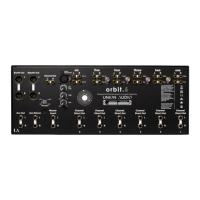8
A discrete circuit is one built from individual components, as opposed to an integrated circuit (IC) where all the components are etched onto a single wafer
of silicon.
The basic building block of analogue electronics is the operaonal amplier, or op-amp; a device with a dierenal input and a single output. Commercial op
-amp ICs are complex, containing many transistors, resistors and capacitors to ensure stable, repeatable and consistent operaon in a wide range of dierent
circuit topologies, many of which will not be audio related. A typical mixer will contain dozens of these ICs that the audio signal will have to pass through on
its journey from input to output. And while the added complexity might ensure good
measured performance, it doesn't necessarily translate into what sounds pleasing to the
ear, as each component will have a ny eect on the overall tonality.
A purpose made discrete audio op-amp however, only needs sucient complexity to
perform its intended funcon, and can therefore be designed with far fewer
components.
In addion, each of these components can be individually chosen for best audio
performance, rather than being limited by what can be etched onto a single wafer of
silicon.
The two schemacs (above le) highlight the extremes in complexity between very a
simple discrete op-amp and a typical commercial design. In reality the simple discrete op-
amp, would have limited performance, though it can be made to work quite well.
The heart of Orbit.6 is our own discrete op-amp, designed and manufactured inhouse. In
terms of complexity it is halfway between the two extremes, but oers a similar
measured performance to a commercial IC when used in typical audio applicaons.
Featuring matched transistor pairs, it oers wide bandwidth, high slew rate, low
distoron and high output current, and plays a key role in dening the disncve sound
characterisc of the Orbit.6.
Why Discrete?

